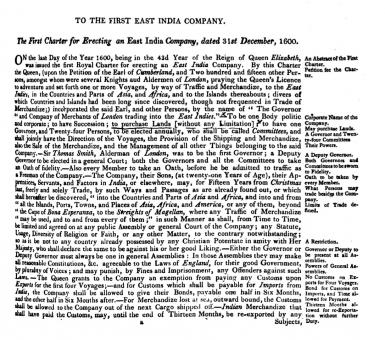
The Rise of the Company-State
The English East India Company (EIC) was created first in 1600 and its Dutch rival, the Vereenigde Oost-Indische Compagnie or VOC, established two years later in 1602. From the beginning, the companies looked very different. The EIC was formed by private merchants who desired to access trade in Asia, while the VOC was engineered by officials attached to the Dutch state who compelled the merger of a number of smaller trading organizations to form the VOC. The Dutch Company was also equipped with expansive powers which turned it into a hybrid organization, part company and part state. This composite nature can be traced directly back to the company’s foundational document, the 1602 charter, and particularly to a single article. Buried among a sequence of dry clauses stipulating the organization’s complicated business structure can be found article 35, which gave the VOC sovereign rights of the kind more conventionally monopolized by the state.
Source: Charter of the East India Company
Analysis
This is the first charter issued to the English East India Company in 1600. It gives the new organization important powers but it also puts it at a clear disadvantage to its Dutch rival, which was given explicit powers to wage war and conduct diplomacy.
Translation/Transcription
Know ye, therefore, that we, Greatly tendering the hounor of our nation, the wealth of our people, and the encouragement of them, and others of our loving subjects in their good enterprizes, for the increase of our navigation, and the advancement of our lawful traffick to the benefit of our Commonwealth, have of our special grace, certain knowledge, and mere motion, given and granted and by these presents, for us, our heirs and successors do give and grant unto our said loving subjects before in these presents expressly named, that they and every of them from henceforth be, and shall be one body corporate and politick, in deed and in name, by the name of the Governor and Company of Merchants of London, trading into the East Indies, and them by the name of the Governor and Company of Merchants of London, trading to the East Indies, one body and corporate and politick, in deed and in name, really and fully for us our heirs and successors we do order, make, ordain, constitute, establish and declare, by these presents, and that by the same name of Governor and company of merchants of London, trading into the East Indies, they shall have succession, and that they and their successors, by the name of the Governor and Company of Merchants of London, trading into the East Indies,



